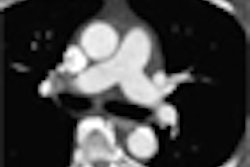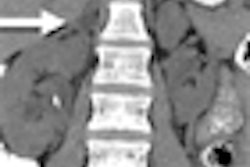NEW ORLEANS - Researchers at this week's American Thoracic Society (ATS) meeting suggested that dynamic 320-slice CT can noninvasively pinpoint vocal cord dysfunction among patients with asthma.
"Our studies indicate that laryngeal function may be abnormal in asthma," said Dr. Peter Holmes, a respiratory specialist at Monash Medical Centre in Melbourne, Australia, in his poster presentation.
Holmes and colleagues employed a CT scanner with a 320-row detector array (Aquilion One, Toshiba Medical Systems, Otawara, Japan) to scan a 16-cm z-axis volume. Images were continuously obtained over the entire respiratory cycle from the beginning of inspiration to the beginning of the following breathing cycle. Radiation doses were in the 0.8-3.0 mSv range.
The researchers scanned 10 normal subjects (average age, 40) and 11 subjects with asthma (average age, 49). Half the control group subjects were women, and nine of the 11 asthma patients were women. The asthma patients had been diagnosed with the disease for an average of 19.7 years. The researchers also scanned five patients with unexplained breathlessness.
Of the 11 patients with asthma, eight had been diagnosed with severe asthma -- and six of those patients exhibited vocal cord dysfunction, Holmes said. Of the two patients with moderate asthma, one had vocal cord dysfunction. The one patient in the study with mild asthma did not exhibit any vocal cord dysfunction.
Of the patients with unexplained breathlessness, two were diagnosed as having vocal cord dysfunction; one patient had vocal cord paralysis, one was diagnosed with tracheal stenosis, and one patient was diagnosed with obstructive sleep apnea.
The researchers determined the real-time vocal cord diameter during inspiration and expiration, and normalized that to the tracheal diameter, which is constant due to cartilage.
According to Holmes, results indicated that a ratio greater than 50% is normal. Ratios less than 30% would represent abnormal function, and ratios greater than 30% and less than 50% represent a gray zone, he said.
He noted that vocal cord dysfunction may mimic asthma or make asthma more difficult to control. Although the gold standard for diagnosing vocal cord dysfunction entails direct laryngoscopy during symptoms demonstrating paradoxical closure of the vocal cords, the procedure is invasive and laryngoscope experts are often unavailable in the acute clinical setting.
"Dynamic 320-slice CT of the larynx provides the first noninvasive technique to detect abnormal laryngeal movement," Holmes said. "Our data also suggest that most vocal cord dysfunction -- better named laryngeal dysfunction -- may be an important component of difficult-to-treat asthma."
By Edward Susman
AuntMinnie.com contributing writer
May 19, 2010
Related Reading
CT, MRI show successful vocal cord restoration, May 10, 2006
Copyright © 2010 AuntMinnie.com




















